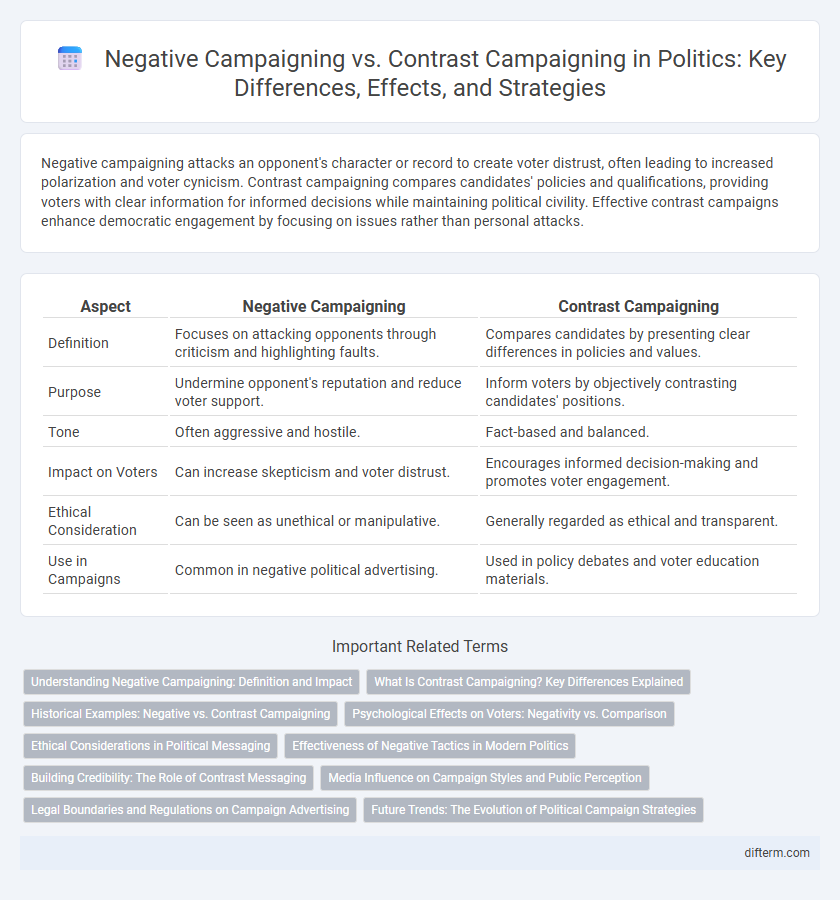Negative campaigning attacks an opponent's character or record to create voter distrust, often leading to increased polarization and voter cynicism. Contrast campaigning compares candidates' policies and qualifications, providing voters with clear information for informed decisions while maintaining political civility. Effective contrast campaigns enhance democratic engagement by focusing on issues rather than personal attacks.
Table of Comparison
| Aspect | Negative Campaigning | Contrast Campaigning |
|---|---|---|
| Definition | Focuses on attacking opponents through criticism and highlighting faults. | Compares candidates by presenting clear differences in policies and values. |
| Purpose | Undermine opponent's reputation and reduce voter support. | Inform voters by objectively contrasting candidates' positions. |
| Tone | Often aggressive and hostile. | Fact-based and balanced. |
| Impact on Voters | Can increase skepticism and voter distrust. | Encourages informed decision-making and promotes voter engagement. |
| Ethical Consideration | Can be seen as unethical or manipulative. | Generally regarded as ethical and transparent. |
| Use in Campaigns | Common in negative political advertising. | Used in policy debates and voter education materials. |
Understanding Negative Campaigning: Definition and Impact
Negative campaigning involves highlighting an opponent's flaws and failures to undermine their credibility, often employing personal attacks or misinformation. This tactic can polarize voters, diminish political discourse quality, and occasionally backfire by generating sympathy for the targeted candidate. Understanding its impact is essential for assessing election dynamics and voter behavior in competitive political environments.
What Is Contrast Campaigning? Key Differences Explained
Contrast campaigning highlights clear policy differences and candidate qualifications, aiming to inform voters through factual comparisons rather than personal attacks. Negative campaigning primarily relies on criticizing opponents to create doubt and fear, often overshadowing substantive issues. By focusing on contrasts, campaigns promote a more constructive political dialogue that encourages voter education and issue-based decision-making.
Historical Examples: Negative vs. Contrast Campaigning
Historical examples highlight the strategic differences between negative and contrast campaigning in politics. The 1964 U.S. presidential election saw Lyndon B. Johnson's campaign employ negative tactics against Barry Goldwater, emphasizing fears of nuclear war, while contrast campaigning appeared in the 2008 Obama vs. McCain race, where Obama's ads contrasted policies without personal attacks. These cases reveal how negative campaigning often aims to undermine opponents emotionally, whereas contrast campaigns focus on policy differences to inform voters.
Psychological Effects on Voters: Negativity vs. Comparison
Negative campaigning often triggers fear and distrust among voters, leading to emotional responses that can decrease overall political engagement and increase cynicism. Contrast campaigning, which emphasizes comparisons between candidates' policies and qualifications, tends to foster more informed decision-making by encouraging voters to evaluate differences without the emotional burden of hostility. Psychological research suggests contrast appeals are less likely to provoke defensive biases than negative appeals, making them more effective at maintaining voter attention and promoting rational judgment.
Ethical Considerations in Political Messaging
Negative campaigning often involves personal attacks and deceptive tactics that can undermine democratic discourse and erode public trust in political institutions. Contrast campaigning emphasizes comparing policy positions and records, fostering informed voter decisions without resorting to harmful rhetoric. Ethical considerations demand transparency, accuracy, and respect in political messaging to maintain the integrity of electoral processes and promote a healthy democratic environment.
Effectiveness of Negative Tactics in Modern Politics
Negative campaigning often yields short-term gains by highlighting opponents' flaws, but it can erode voter trust and increase political polarization. Contrast campaigning, which compares candidates' policies and records, tends to foster informed decision-making and sustain long-term voter engagement. Research indicates that while negative tactics grab attention, combining them with clear policy contrasts enhances overall campaign effectiveness in modern political landscapes.
Building Credibility: The Role of Contrast Messaging
Contrast campaigning enhances building credibility by clearly differentiating a candidate's policies and values from opponents without resorting to overt negativity. Unlike negative campaigning, which often focuses on attacking character flaws, contrast messaging emphasizes substantive comparisons grounded in facts, fostering trust among voters. Effective contrast strategies reinforce a candidate's positive attributes while maintaining professionalism, thereby increasing voter confidence and perceived authenticity.
Media Influence on Campaign Styles and Public Perception
Negative campaigning leverages media outlets to highlight opponents' flaws, often increasing public skepticism and polarization, while contrast campaigning uses media to provide clear distinctions between candidates' policies, fostering informed voter decisions. Media framing significantly shapes public perception by either amplifying personal attacks in negative campaigns or emphasizing substantive policy comparisons in contrast campaigns. Research shows that media emphasis on negative content generates higher engagement but risks voter cynicism, whereas contrast campaigns tend to enhance campaign transparency and voter trust.
Legal Boundaries and Regulations on Campaign Advertising
Legal boundaries on negative campaigning often involve strict regulations to prevent defamation, false claims, and misinformation, ensuring candidates do not engage in slanderous attacks. Contrast campaigning, which compares candidates' policies or records, is generally more permissible but still subject to truth-in-advertising laws and requirements for factual accuracy. Campaign advertising regulations mandate transparency, disclaimers, and adherence to campaign finance laws to maintain ethical standards and prevent voter manipulation.
Future Trends: The Evolution of Political Campaign Strategies
Negative campaigning focuses on attacking opponents' character and records, while contrast campaigning presents clear comparisons between candidates' policies and strengths. Future trends indicate a shift towards data-driven strategies that blend emotional appeals with fact-based contrasts to engage increasingly skeptical electorates. The rise of digital platforms enables precise targeting, amplifying the impact of nuanced contrast messaging over blunt negativity in political campaigns.
Negative campaigning vs Contrast campaigning Infographic

 difterm.com
difterm.com